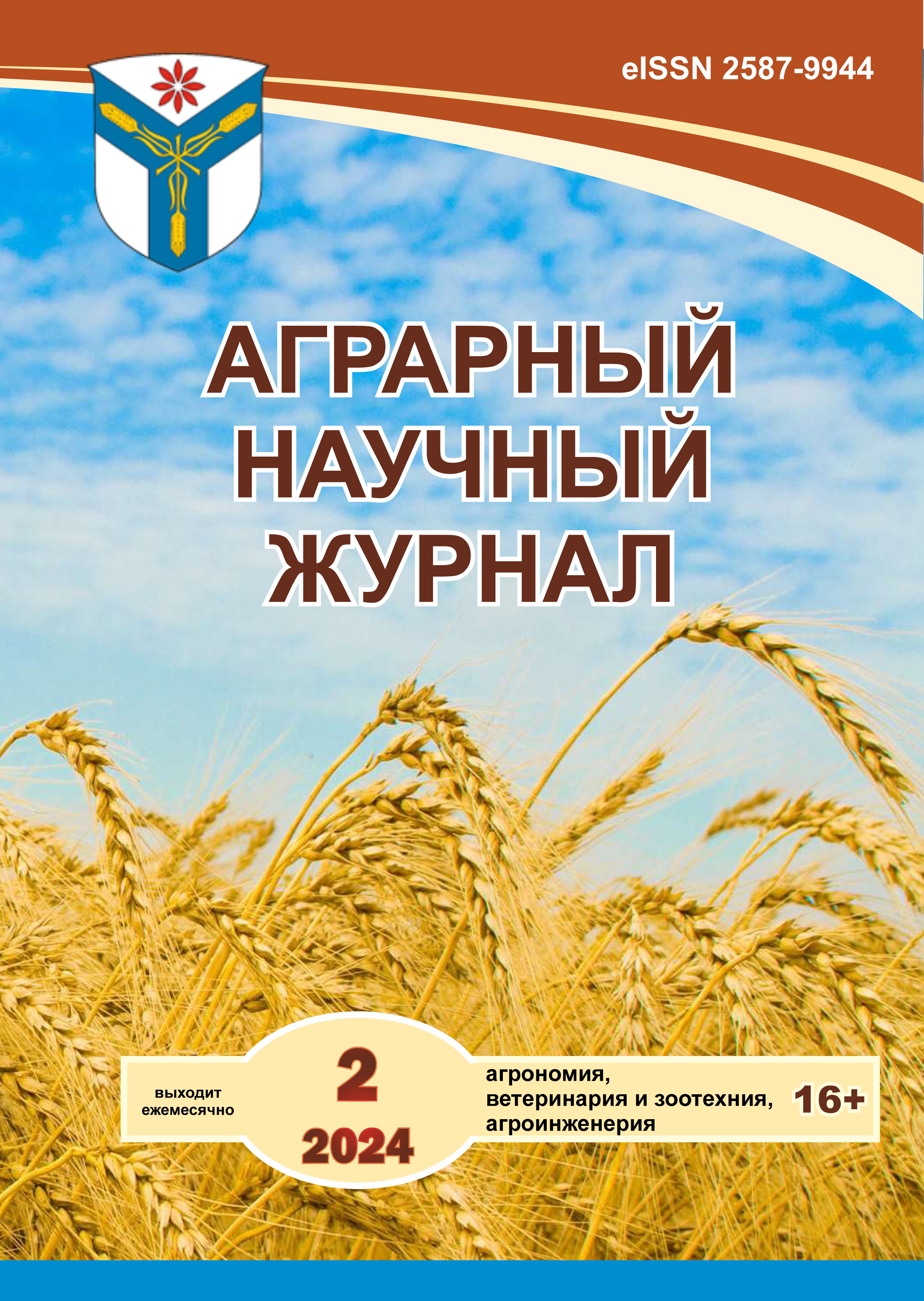Processing of chicken manure of different ages by modifying the basic technology into bio-compost and testing it on potatoes
DOI:
https://doi.org/10.28983/asj.y2024i2pp45-54Keywords:
bird droppings, sawdust, solid-phase aerobic fermentation, physical chemistry of the process, temperature conditions, biocompost, nutrientsAbstract
Features of the development of an algorithm for preparing new biocompost from manure of different ages under controlled conditions are presented. An impressive series of preliminary experiments with composting manure in various combinations, both with and without the addition of sawdust, allowed us to select the best process for solid phase aerobic fermentation (SPAF). A process was chosen for which the initial mixture is made up of rotted (from 2 years) and semi-rotted (from 6 months) droppings in a ratio of 3:1 with the addition of 10 % sawdust, while an optimal temperature regime is created in the fermentable mass. This fermentation process was accompanied by the expected losses of carbon and nitrogen, reflecting the actually natural processes of biocomposting in the piles. Oxidation of the components of the fermented mass occurred, as evidenced by the intensive increase in nitrate accumulation against the background of a decrease in ammonia nitrogen. The new biocompost was characterized by a fairly high content of basic nutrients, %: Ntotal - 3.80, P2O5 - 2.1, K2O - 2.45, humidity - 55 %, slightly alkaline pH 8.5. A negative, difficult to eliminate consequence of the updated SPAF process is the unpleasant odor of biocompost, the reduction of which can only be achieved through prolonged ventilation, which undoubtedly increases the cost of production. The initial testing of the new biocompost in 2023 on potatoes of the Queen Anna variety at an application rate of 15 t/ha ensured an increase in its yield compared to the control (without fertilizers) by 87 %. The new biocompost is recommended for use as a safe organic fertilizer and as a component for the production of soils. The benefits of this type of SPAF are associated with the abandonment of an expensive ingredient - peat, the use of a cheap livestock by-product (poultry manure) to the maximum extent, as well as the introduction of forest processing waste (sawdust) in a very small volume into the initial mixtures.
Downloads
References
Архипченко И.А., Бакина Л.Г., Брюханов А.Ю., Орлова О.В., Тарасов С.И. Трансформация микробного сообщества и органического субстрата при аэробной ферментации помета // Экология и промышленность России. 2020. Т. 24. № 8. С. 22-27. DOI: 10.18412/1816-0395-2020-8-22-27
Качурин В.В., Наруков Е.С., Редреев Г.В. Современные технологии переработки куриного помета // Вестник Омского ГАУ. 2022. №4 (48). С. 207-216. DOI: 10.48136/2222-0364_2022_4_207
Методические рекомендации по технологическому проектированию систем удаления и подготовки к использованию навоза и помета РД-АПК 1.10.15.02-17. 2020. 189 с.
Основные итоги сельскохозяйственной микропереписи 2021 года. Статистический сборник / Федеральная служба государственной статистики. М.: ИИЦ «Статистика России», 2022. 420 с. https://rosstat.gov.ru/storage/mediabank/Census_agr_2021.pdf
Попов В.Н., Корнеева О.С., Искусных О.Ю., Искусных А.Ю. Инновационные способы переработки биоотходов птицеводства // Вестник Воронежского государственного университета инженерных технологий. 2020. №82(1). С.194-200. https://doi.org/10.20914/2310-1202-2020-1-194-200
Производство, изучение и применение удобрений на основе птичьего помета. Монография под общ. ред. А.И. Иванова, В.В. Лапы. СПб: ФГБНУ АФИ, 2018. 317 с. DOI: 10.25695/agrophys.mono.ivanovai.fertilizer.2018.317
Рабинович Г.Ю. Научные основы, опыт продвижения и перспективы биотехнологических разработок: монография. Тверь: Твер. ГУ, 2016.196 с.
Терентьева Э.П., Удовенко Н.К., Павлова Е.А., Алиев Р.Г. Основы химии целлюлозы и древесины. СПб.: ГОУВПО СПбГТУ РП, 2010. 23 с.
Теучеж А.А. Применение птичьего помета в качестве органического удобрения // Научный журнал КубГАУ. 2017. № 128. С. 914-931. DOI: 10.21515/1990-4665-128-061
Тюрин В.Г., Мысова Г.А., Потемкина Н.Н., Сахаров А.Ю., Бирюков К.Н., Кочиш О.И. Химический состав и токсикологические показатели органических отходов при различных способах их переработки // Российский журнал «Проблемы ветеринарной санитарии, гигиены и экологии». 2020. № 4 (36). С. 486-493. DOI: 10.36871/vet.san.hyg.ecol.202004013
Федеральный классификационный каталог отходов. Приказ Росприроднадзора от 22.05.2017 №242 (с изменениями от 29.03.2021 N 149). Федеральный классификационный каталог отходов. – Приказ Росприроднадзора от 22.05.2017 №242 (с изменениями от 29.03.2021 N 149) https://normativ.kontur.ru/document?moduleId=1&documentId=429132
Agbede T.M., Adekiya A.O., Eifediyi E.K. Impact of poultry manure and NPK fertilizer on soil physical properties and growth and yield of carrot // Journal of Horticultural Research. 2017. Vol. 25. No 1. Р. 81-88. DOI:10.1515/johr-2017-0009
Ramzan N., Ashraf A., Naveed S., Malik A. Simulation of hybrid biomass gasification using Aspen plus: A comparative performance analysis for food, municipal solid and poultry waste // Biomass and Bioenergy. 2011. Vol. 35. No 9. P. 3962–3969.
Zhang W., Lang Q., Pan Z., Yingqing J., Liebetrau J., Nelles M., Dong H., Dong R. Performance evaluation of a novel anaerobic digestion operation process for treating high-solids content chicken manure: Effect of reduction of the hydraulic retention time at a constant organic loading rate |// Waste Management. 2017. Vol. 64, P. 340-347. https://doi.org/10.1016/j.wasman.2017.03.034
Downloads
Published
Issue
Section
License
Copyright (c) 2024 Agrarian Scientific Journal

This work is licensed under a Creative Commons Attribution-NonCommercial-NoDerivatives 4.0 International License.








